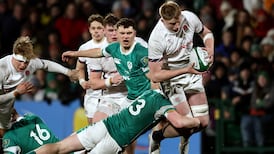The Solheim Cup has almost sneaked up on us. No mad furore over the wild card picks - European captain Dale Reid had five of them - and no commotion in the locker room about who should or shouldn't be in the side. It would seem to indicate that both Europe and the United States face into the event at Loch Lomond, starting on Friday, without any of the bad blood that lingers among their male equivalents following last year's so-called "Battle of Brookline".
But then, the Solheim Cup is not the Ryder Cup. It doesn't have the same history, or the same pressures. It doesn't evoke the same emotions. Most of the European players ply their trade, and rake in the bucks, on the US LPGA Tour. If Europe lose - again!! - you'd wonder just how much it would hurt the development of the sport on this side of the Atlantic. In the five previous encounters in this female version of the Ryder Cup, the US has only lost once (in 1992).
Indeed, the make-up of the European team, with six Swedes in a side of 12, adequately reflects the powerbase of women's professional golf in Europe. And, ironically, the one sniff of a possible spat in the home camp centred on the inclusion of Janice Moodie as one of Reid's captain's picks. Not because she isn't good enough, but because - so the whispers went - some Europeans apparently considered her "aloof" and "too Americanised".
Moodie, who has earned over £1 million in less than three years as a professional, is the only Scot in the team. Early last month, Reid ended the speculation that she would be by-passed - possibly in favour of another US-based Scot, Catriona Matthew - when including her as a pick along with four Swedes: Carin Koch, Helen Alfredsson, Liselotte Neumann and Catrin Nilsmark.
If Europe's team appears top-heavy with Swedes, the return of the event to Scotland - scene of their only win in the event, at Dalmahoy in 1992 - could bode well. So, too, could the inclusion of Moodie.
The family home of the 27-yearold San Jose graduate is less than 25 minutes drive from the Loch Lomond course where she has enjoyed playing privileges for the past four years. "It's not foreign territory to me and, being so close to home in Glasgow, there is a definite sense of comfort," remarked Moodie.
As far as Moodie's place in the team is concerned, her results in the US over the past two years should have made her an automatic choice. She's had 15 top-10 finishes over the past two years and secured her first victory, in the Shop Rite Classic, earlier this season. In her debut year in 1998, she was runner-up to Se Ri Pak for rookie honours.
That alleged aloofness, or self-confidence, was apparently the only thing that stood in her way and, after an arranged meeting with Reid didn't go too well, Moodie herself wondered if she would actually get the call-up to the team.
"The (US) LPGA Tour was my first tour, and my home tour," said Moodie, who followed a seemingly natural progression to the US LPGA Tour when graduating from college where she was twice an All-American. "For a lot of them, the European women's tour is their first and home tour. Certainly, I'd go back to play in Scotland if we still had an event there, but America is where I make my living."
Even with so many players who earn their living on the US LPGA Tour in the side, Europe - who consist of Sophie Gustafson, Trish Johnson, Laura Davies, Alison Nicholas, Annika Sorenstam, Patricia Meunier Lebouc and Raquel Carriedo along with the five captain's picks - seem to face an uphill fight in their attempt to reclaim the trophy.
In contrast to the European team (seven qualifiers, five wild cards), 10 of the Americans actually played their way onto the team. When US captain Pat Bradley nominated her two wild card selections last week, she went for experience in choosing Beth Daniel and Brandie Burton to join Juli Inkster, Meg Mallon, Dottie Pepper, Rosie Jones, Sherri Steinhauer, Pat Hurst, Kelly Robbins, Michelle Redman, Nancy Scranton and Becky Iverson.
Not for the first time in this competition, the United States appear to hold the upper hand. For the Solheim Cup to emerge from the shadows of the Ryder Cup, however, an upset from the Europeans, akin to what happened at The Belfry in 1985 which forever changed the face of the Ryder Cup, could be needed. Will we be left waiting?










